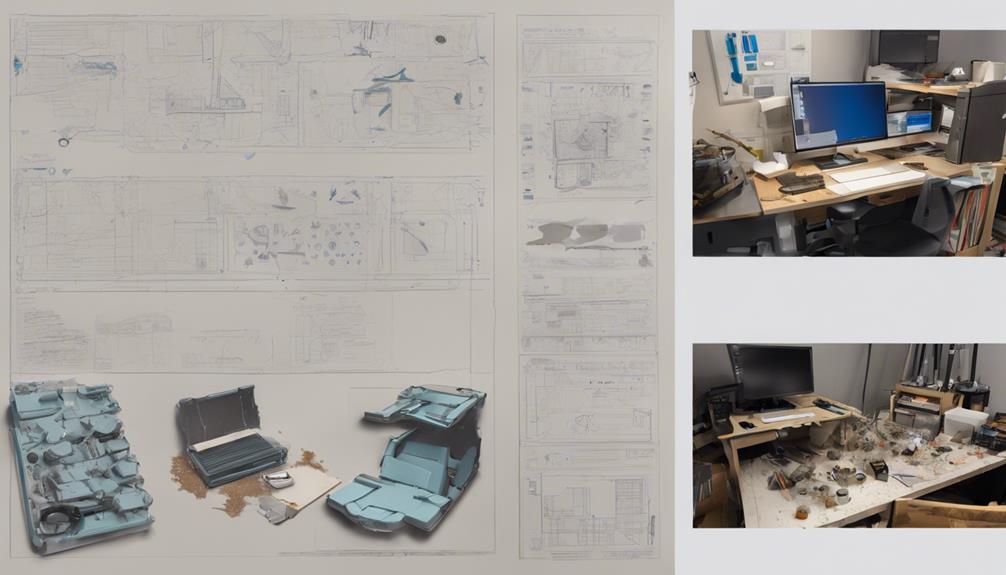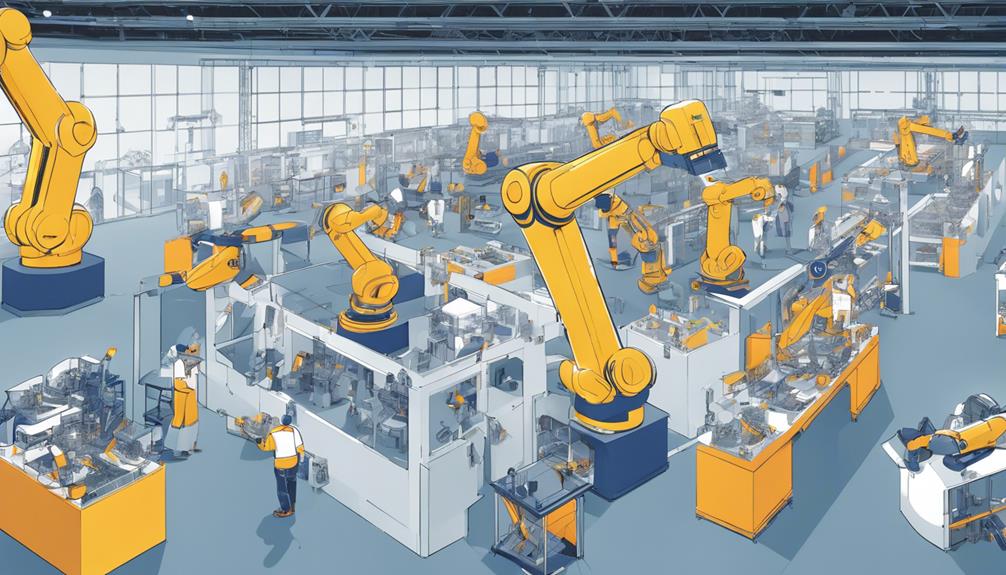Effective design for manufacturability (DFM) is vital in today's competitive manufacturing landscape, enabling companies to streamline production, reduce costs, and improve product reliability. To achieve this, simplify your design by minimizing components and standardizing parts. Choose the right materials, considering strength, machinability, and availability. Optimize your design for manufacturing process efficiency, integrating considerations into your design. Design for assembly, enhancing product reliability and streamlining production. Consider the service environment and test early to prevent costly redesigns. By following these essential DFM tips, manufacturers can enhance overall manufacturing efficiency and gain a competitive edge – and there's more to explore in implementing a successful DFM strategy.
Key Takeaways
- Simplify design features and standardize parts to minimize production complexity and facilitate automated assembly.
- Opt for cost-effective materials that prioritize strength, machinability, and availability to enhance product performance.
- Integrate manufacturing considerations into design to simplify assembly processes, minimize part counts, and utilize standard components.
- Apply Design for Assembly principles to reduce part count and assembly complexity, and enhance scalability and flexibility in production.
- Validate design assumptions and make data-driven decisions through thorough testing and validation early in the design process.
Simplify Your Design
By minimizing the number of components and simplifying design features, manufacturers can greatly reduce production costs and errors, ultimately leading to increased efficiency and quality. This design approach enables the streamlining of the production process, resulting in lower overall costs and reduced assembly time.
A simplified design also facilitates the standardization of parts, which enhances manufacturability and improves consistency. Additionally, minimizing complexity in design facilitates automated assembly, increasing production efficiency and reducing the risk of manufacturing issues. With fewer components, handling becomes easier, and the likelihood of errors is notably reduced.
By simplifying design features, designers can eliminate unnecessary complexity, promoting a more efficient production process. By doing so, manufacturers can reap the benefits of reduced part count, lower production costs, and improved product quality.
Choose the Right Materials

Selecting the essential materials is important in design for manufacturability, as it greatly influences production costs, quality, and efficiency. Material selection can have a notable impact on manufacturing cost, quality, and efficiency. To achieve successful design for manufacturability, it is essential to opt for materials that are readily available and cost-effective for production.
| Material Selection Criteria | Description |
|---|---|
| Material Strength | Choose materials with sufficient strength to withstand manufacturing processes |
| Machinability | Select materials that are easy to machine, reducing production time and cost |
| Availability | Opt for readily available materials to reduce lead times and manufacturing cost |
| Cost-Effectiveness | Prioritize cost-effective materials to minimize production expenses |
Efficient material selection is key to successful design for manufacturability. By considering material strength, machinability, and compatibility with manufacturing processes, you can streamline production, reduce lead times, and minimize manufacturing costs. By making informed material selection decisions, you can ensure a cost-effective and efficient production process, resulting in successful design for manufacturability.
Optimize for Manufacturing Process

Optimizing for the manufacturing process involves careful consideration of material selection and design strategies to guarantee efficient production. By choosing materials that are compatible with standard manufacturing processes and designing products with production constraints in mind, designers can minimize production costs, reduce errors, and accelerate time-to-market.
In this section, we will explore the importance of material selection and process-friendly design in optimizing the manufacturing process.
Material Selection Matters
A product's material composition plays a vital role in determining its manufacturability. The properties of the chosen material can either facilitate or hinder the production process. Material selection is crucial in manufacturing processes as it affects production costs, lead times, and overall product quality.
Ideal material choices streamline manufacturing processes, reduce waste, and enhance efficiency during production. When selecting materials, it is important to consider properties like strength, durability, machinability, and cost to guarantee manufacturability.
Material optimization for the manufacturing process leads to cost savings, improved product performance, and streamlined production workflows. Proper material selection aligns with manufacturing capabilities, ensuring smooth production and high-quality end products.
By considering material properties and optimizing material selection, manufacturers can reduce production costs, improve efficiency, and enhance product quality. Effective material selection is essential for achieving streamlined production, reduced waste, and improved product performance.
Process-Friendly Design
By integrating manufacturing considerations into the design phase, companies can create process-friendly products that simplify assembly, reduce part counts, and utilize standard components, ultimately leading to improved manufacturing efficiency and reduced production costs. This approach enables companies to optimize their product design for the manufacturing process, minimizing manufacturability issues and streamlining production.
By embracing process-friendly design, companies can:
- Simplify assembly processes, reducing labor costs and lead times
- Minimize part counts, reducing material costs and inventory management
- Utilize standard components, reducing procurement costs and lead times
- Improve product quality and manufacturability by implementing DFM principles
- Enhance scalability and flexibility in production, enabling faster response to changing market demands
Design for Assembly

When designing for assembly, it is imperative to take into account three key points:
- Minimizing part count
- Simplifying component design
- Optimizing assembly sequence
By implementing these strategies, manufacturers can greatly reduce production costs, enhance product quality, and boost manufacturing efficiency.
Minimize Part Count
To minimize part count, an important aspect of design for assembly, designers should aim to consolidate components into multifunctional parts, thereby simplifying the overall assembly process. By doing so, manufacturers can reduce assembly time and complexity, leading to significant cost savings and efficient production processes.
Here are the benefits of minimizing part count:
- Enhanced product reliability: Fewer parts in assembly decrease the chances of errors and improve overall product performance.
- Streamlined production: Designing with fewer parts streamlines production, lowers labor costs, and improves overall manufacturability.
- Improved quality: Simplifying component designs by minimizing parts enhances product reliability and quality.
- Increased efficiency: Optimizing part count through design for assembly principles enhances manufacturing efficiency and productivity.
- Reduced costs: Minimizing part count leads to significant cost savings, making it an important aspect of design for manufacturability.
Simplify Component Design
Simplifying component design is an essential aspect of design for assembly, as it enables manufacturers to reduce part count and assembly complexity, thereby streamlining production processes and lowering manufacturing costs. By minimizing parts, manufacturers can reduce assembly time and effort, leading to improved manufacturing efficiency. Standardizing components also enhances ease of assembly and reduces errors, further improving assembly efficiency.
| Design Aspect | Before Simplification | After Simplification |
|---|---|---|
| Part Count | High | Low |
| Assembly Complexity | High | Low |
| Manufacturing Efficiency | Low | High |
| Product Quality | Average | High |
Optimize Assembly Sequence
By optimizing the assembly sequence, manufacturers can greatly reduce production time and costs by minimizing handling steps, thereby streamlining the overall assembly process. This is achieved by applying Design for Assembly (DFA) principles, which simplify assembly by reducing part count and standardizing components. Efficient assembly design reduces labor costs and assembly time, making it an essential aspect of Design for Manufacturability.
Here are the benefits of optimizing assembly sequence:
- Reduces handling steps, thereby streamlining production
- Facilitates automated assembly processes for increased efficiency
- Prioritizes ease of handling in design, reducing errors and improving overall product quality
- Enables efficient assembly design, reducing labor costs and assembly time
- Allows for standardization of components, reducing part count and complexity
Consider the Service Environment

Operating in harmony with its intended environment is vital for a product's success, as neglecting to take into account the service environment can lead to premature failures and costly consequences.
When designing a product, it is essential to take into consideration the service environment to guarantee peak product performance. This involves evaluating factors such as temperature, humidity, vibration, and potential hazards that may impact product performance. By doing so, designers can select materials and components that can withstand the specific environmental conditions the product will be exposed to.
A well-designed product that acknowledges its service environment can prevent premature product failures, increase customer satisfaction, and reduce the likelihood of costly repairs and replacements.
In the context of Design for Manufacturing, acknowledging the service environment is critical to achieving top-notch product performance and minimizing the risk of product failures. By integrating this critical aspect into the design process, manufacturers can ensure that their products meet customer expectations and withstand the demands of their intended operating conditions.
Test and Validate Early

To guarantee that a product meets its intended performance and reliability standards, thorough testing and validation must occur early in the design process, building upon the consideration of the service environment. This critical step assures that design flaws are identified and addressed early on, preventing costly rework and redesign.
By testing and validating early, designers can:
- Identify and mitigate potential design flaws before they become costly problems
- Ensure compliance with regulatory requirements, avoiding costly redesign and rework
- Optimize manufacturing processes for efficiency and quality
- Validate design assumptions and make data-driven decisions
- Avoid late-stage design changes that can derail production timelines and budgets
Early validation and testing enable designers to iterate and refine their designs, ensuring that the final product meets performance and reliability standards.
Streamline Production With DFM

Optimizing product design for efficient manufacturing processes, Design for Manufacturability (DFM) techniques facilitate streamlined production, reduced costs, and enhanced product reliability. By applying DFM principles, manufacturers can minimize production costs, reduce complexity, and guarantee product reliability, ultimately leading to efficient manufacturing and improved production efficiency.
Implementing DFM techniques early in the design phase helps avoid costly redesigns and production delays, ensuring shorter production timelines and cost savings. Additionally, DFM facilitates easier scaling up of production with minimal challenges, enhancing overall manufacturing efficiency.
Frequently Asked Questions
How Do I Balance DFM With Innovative Design Creativity?
As innovators, we stand at the crossroads of creativity and practicality, where visionary design meets manufacturing realities. Balancing DFM with innovative design creativity requires embracing a harmonious tension between artistic expression and production feasibility.
What Is the Ideal DFM Training for My Design Team?
When crafting an ideal DFM training program for your design team, consider a thorough curriculum that covers the fundamentals of manufacturability, material science, and production processes.
Include interactive sessions, case studies, and hands-on exercises to facilitate practical understanding.
Invite industry experts to share real-world experiences and best practices.
Make certain training is tailored to your team's specific needs and design responsibilities, focusing on applicable skills to enhance their DFM expertise.
Can DFM Principles Be Applied to Existing Product Lines?
Applying Design for Manufacturability (DFM) principles to existing product lines is not only possible but also highly beneficial. By retroactively integrating DFM principles, manufacturers can optimize production processes, reduce costs, and enhance product quality.
A thorough analysis of existing designs and production workflows will identify areas for improvement, allowing for targeted implementation of DFM strategies to maximize efficiency and profitability.
How Does DFM Impact the Environmental Sustainability of Products?
When examining the environmental sustainability of products, recognizing the significant impact of Design for Manufacturability (DFM) principles is crucial. By optimizing product design for efficient production, DFM inherently reduces waste generation, energy consumption, and resource depletion.
This, in turn, minimizes the ecological footprint of products, contributing to a more sustainable future. By embracing DFM, manufacturers can create environmentally conscious products that not only benefit the planet but also enhance their brand reputation and bottom line.
Are There DFM Software Tools Available for Small Businesses?
For small businesses, leveraging design for manufacturability (DFM) software tools is essential to streamline production and reduce costs.
Fortunately, a range of accessible DFM software options exist, catering to small businesses' unique needs and budgets.
Notable examples include Fusion 360, Autodesk Eagle, and SolidWorks, which offer user-friendly interfaces, simulation capabilities, and real-time feedback to optimize product design for efficient manufacturing.


